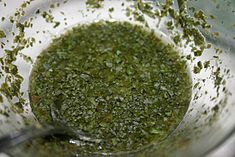
Mint sauce is a green sauce popular in the United Kingdom, made from finely chopped spearmint leaves soaked in vinegar, and a small amount of sugar. It is a traditional accompaniment to roast lamb.

Mint sauce is a green sauce popular in the United Kingdom, made from finely chopped spearmint leaves soaked in vinegar, and a small amount of sugar. It is a traditional accompaniment to roast lamb.
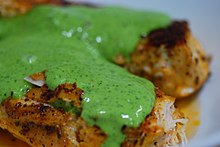
There are many different species of mint, but the one used most widely in Western cooking is spearmint (Mentha spicata). It is native to the Mediterranean area but is found in many other parts of Europe and in North America. The Oxford Companion to Food calls it "[v]ery widely cultivated and used ... 'the mint' of cooks, the one commonly used for mint sauce and for flavouring new potatoes and peas, in Arab mint tea, etc." [1]
The Ancient Roman naturalist Pliny the Elder wrote that mint "stirs up the mind to a greedy taste in meat". [2] The later Roman writer Apicius gave a recipe for mint sauce which he said complemented the flavours of roast lamb (or suckling kid). [3] By the Middle Ages mint was commonly found in European medicinal and kitchen gardens, as well as growing wild. [2]
On the origins of mint sauce, the food historian Dorothy Hartley wrote, "Most sheep had their lambs down in the warm valley grazing lands where the streams ran, and mint grew in abundance. Hence mint sauce with lamb." [4] Mint sauce was being made in England as early as the 3rd century, [5] and the practice of serving it with lamb was well established in English cooking before the mid-18th century. [6]
In the Middle Ages green sauces made with mint or other herbs were common in French and Italian cuisine, [7] but their use declined as Europe entered the Modern Era. [8] Louis-Eustache Ude commented in an 1816 recipe for roast lamb, "In France we serve it up with Maître d'Hôtel but in England you send up with gravy under it, and in a sauceboat mint-sauce with sugar and vinegar. [9] Marcel Boulestin wrote in 1936, "I think I am one of the very few French people who genuinely like mint sauce", [10] and he reported his father's view: "'Do you mean to say that they really eat mint with lamb? ... What a funny country'". [11]
According to Florence Jack in her 1914 Cookery for Every Household, mint sauce contains chopped fresh mint, brown sugar, and malt vinegar, mixed with boiling water and left to stand for several hours before serving. [12] In Spices, Salt and Aromatics in the English Kitchen (1970) Elizabeth David broadly agreed with Jack's recipe, but recommended using white wine vinegar as "less savage". [13] In her Book of Mint (1993) Jackie French concurs with David, but suggests letting the cooked sauce stand for at least a day and preferably a month. [2] Some earlier recipes left the mixture unboiled and did not let it stand. David commented that letting the finished sauce stand was, together with the use of brown sugar, the reason why Jack's sauce was superior to "the routine English one". [13]
Mint sauces may include fruits in their preparation, such as raspberries. [14]
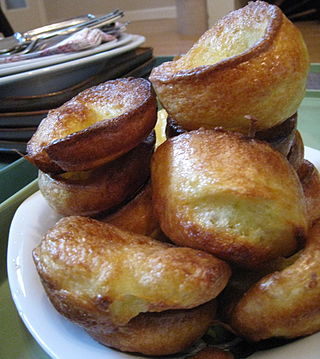
Yorkshire pudding is a baked pudding made from a batter of eggs, flour, and milk or water. A common British side dish, it is a versatile food that can be served in numerous ways depending on its ingredients, size, and the accompanying components of the meal. As a first course, it can be served with onion gravy. For a main course, it may be served with meat and gravy, and is part of the traditional Sunday roast, but can also be filled with foods such as bangers and mash to make a meal. Sausages can be added to make toad in the hole. The 18th-century cookery writer Hannah Glasse was the first to use the term "Yorkshire pudding" in print.

English cuisine encompasses the cooking styles, traditions and recipes associated with England. It has distinctive attributes of its own, but is also very similar to wider British cuisine, partly historically and partly due to the import of ingredients and ideas from the Americas, China, and India during the time of the British Empire and as a result of post-war immigration.

Shepherd's pie, cottage pie, or in its French version hachis Parmentier, is a savoury dish of cooked minced meat topped with mashed potato and baked, formerly also called Sanders or Saunders. The meat used may be either previously cooked or freshly minced. The usual meats are beef or lamb. The two English terms have been used interchangeably since they came into use in the late 18th and early 19th centuries, although some writers insist that a shepherd's pie should contain lamb or mutton, and a cottage pie, beef.

Apicius, also known as De re culinaria or De re coquinaria, is a collection of Roman cookery recipes, which may have been compiled in the fifth century CE, or earlier. Its language is in many ways closer to Vulgar than to Classical Latin, with later recipes using Vulgar Latin added to earlier recipes using Classical Latin.

Hollandaise sauce, meaning Dutch sauce in French, is a mixture of egg yolk, melted butter, and lemon juice. It is usually seasoned with salt, and either white pepper or cayenne pepper.

Avgolemono is a family of sauces and soups made with egg yolk and lemon juice mixed with broth, heated until they thicken.
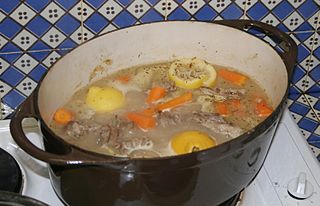
Blanquette de veau is a French veal stew. In the classic version of the dish the meat is simmered in a white stock and served in a sauce velouté enriched with cream and egg. It is among the most popular meat dishes in France.

Green sauce or greensauce is a family of cold, uncooked sauces based on chopped herbs, including the Spanish and Italian salsa verde, the French sauce verte, the German grüne Soße or Frankfurter grie Soß, the British mint sauce and greensauce, and the Argentinian chimichurri.

Alexis Benoît Soyer was a French chef, writer and inventor who made his reputation in Victorian England.

Ragout is a main dish stew.

The Art of Cookery Made Plain and Easy is a cookbook by Hannah Glasse (1708–1770) first published in 1747. It was a bestseller for a century after its first publication, dominating the English-speaking market and making Glasse one of the most famous cookbook authors of her time. The book ran through at least 40 editions, many of which were copied without explicit author consent. It was published in Dublin from 1748, and in America from 1805.
Jugging is the process of stewing whole animals, mainly game or fish, for an extended period in a tightly covered container such as a casserole or an earthenware jug. In France a similar stew of a game animal is known as a civet.
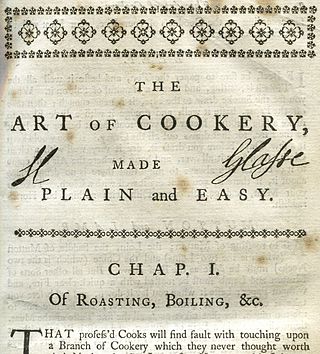
Hannah Glasse was an English cookery writer of the 18th century. Her first cookery book, The Art of Cookery Made Plain and Easy, published in 1747, became the best-selling recipe book that century. It was reprinted within its first year of publication, appeared in 20 editions in the 18th century, and continued to be published until well into the 19th century. She later wrote The Servants' Directory (1760) and The Compleat Confectioner, which was probably published in 1760; neither book was as commercially successful as her first.

Scottish cuisine encompasses the cooking styles, traditions and recipes associated with Scotland. It has distinctive attributes and recipes of its own, but also shares much with other British and wider European cuisine as a result of local, regional, and continental influences—both ancient and modern.

Steak and kidney pudding is a traditional British main course in which beef steak and beef, veal, pork or lamb kidney are enclosed in suet pastry and slow-steamed on a stovetop.

Fricassee or fricassée is a stew made with pieces of meat that have been browned in butter then served in a sauce flavored with the cooking stock. Fricassee is usually made with chicken, veal or rabbit, with variations limited only by what ingredients the cook has at hand.
Elizabeth David, the British cookery writer, published eight books in the 34 years between 1950 and 1984; the last was issued eight years before her death. After David's death, her literary executor, Jill Norman, supervised the publication of eight more books, drawing on David's unpublished manuscripts and research and on her published writings for books and magazines.

The Good Huswifes Jewell is an English cookery book by the cookery and housekeeping writer Thomas Dawson, first published in 1585. It includes recipes for medicines as well as food. To the spices found in Medieval English cooking, the book adds herbs, especially parsley and thyme. Sugar is used in many of the dishes, along with ingredients that are uncommon in modern cooking like violets and rosewater.

Martha Bradley was a British cookery book writer. Little is known about her life, except that she worked as a cook for over thirty years in the fashionable spa town of Bath, Somerset.